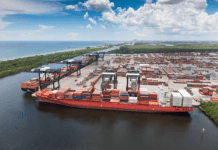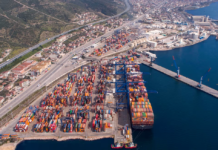
Cargo interests in India’s east coast region are pushing container lines to provide more reliable alternative mainline shipping options via Nhava Sheva/Jawaharlal Nehru Port Trust (JNPT) or Mundra Port as they see no let-up in transshipment bottlenecks at Colombo Port in Sri Lanka.
In conjunction with Container Corporation of India (Concor), Maersk and CMA CGM have now opened new rail connections from India’s East Coast locations to help local exporters divert cargo away from the traditional Colombo routing.
These include block train runs from Durgapur, an inland container depot on the outskirts of Kolkata, and New Mangalore Port (NMPT) in South India.
The train services have been designed to feed cargo onto Maersk and CMA CGM vessels calling at the PSA terminal (BMCT) in Nhava Sheva.
“PSA Mumbai (BMCT) has expanded its hinterland presence via a direct train service to New Mangalore (NMPT), the first-ever from JN Port,” said the Singapore-based terminal operator, adding, “It is thus providing greater flexibility, reliability and eco-friendly options for regional shippers, in close association with CMA CGM and Container Corporation of India Ltd. (Concor).”
The freight of 45 forty-foot containers from Durgapur was reportedly booked to connect Maersk’s ME2 Service, which rotates Nhava Sheva, Salalah, Jeddah, Suez Canal, Port Said East, Port Tangier Med, Algeciras, Valencia, Genoa, Port Said East, Suez Canal, Jeddah, Salalah, Mundra and Nhava Sheva.
“We are already handling regular trains from Goa and Bengaluru ICDs, with mixed export loads from Maersk, CMA CGM and Hapag-Lloyd,” a terminal official in Nhava Sheva told Container News. “The addition of more block train services helps the port to expand its cargo reach.”
As a consequence of acute fuel shortages in Sri Lanka, a problem rooted in the country’s weakening economic conditions, the availability of sufficient trucks has become a major pain point in inter-terminal cargo flows at Colombo.
With no immediate relief in sight from sailing disruptions and trucking limitations in Colombo, Indian east coast shippers, for now, have fewer shipping options that carriers are able to offer them via JNPT or Mundra, either by rail or coastal mode.
“The shipping lines are exploring options, including diversion of cargo from the east coast to the west, Mundra for instance, to try and help the situation,” noted a container shipping industry representative.
Higher volume levels out of India’s west coast have historically caused a concentration of regular/weekly large-size mainline services at JNPT and Mundra. But the growing supply-demand imbalance is a daunting challenge for carriers serving these ports.
Jenny Daniel
India correspondent





